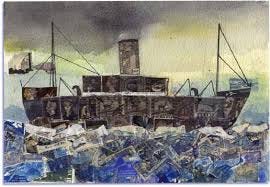
You will recall that John Masefield was Poet Laureate in Great Britain from 1930 to 1967. The mellifluousness (I tried to say mellifluity but the dictionaries show no usage) of his poetry has already captured our attention in his poem, Sea Fever. We see that characteristic here again in his poem, Cargoes, with lines that flow like honey out of the comb, viscously, sweetly and golden.
Quinquereme of Nineveh from distant Ophir,
Rowing home to haven in sunny Palestine,
With a cargo of ivory,
And apes and peacocks,
Sandalwood, cedarwood, and sweet white wine.
Stately Spanish galleon coming from the Isthmus,
Dipping through the Tropics by the palm-green shores,
With a cargo of diamonds,
Emeralds, amethysts,
Topazes, and cinnamon, and gold moidores.
Dirty British coaster with a salt-caked smoke stack,
Butting through the Channel in the mad March days,
With a cargo of Tyne coal,
Road-rails, pig-lead,
Firewood, iron-ware, and cheap tin trays.
There is so much to admire here. The technical stuff first: each stanza of five lines has a similar structure where the first line identifies a ship at sea with a cargo specific to that time; the second line in each stanza starts with the present participle of an action verb and identifies a locale; the third line, a prepositional phrase, starts a list of the cargo on the ship which lines four and five complete. The stanzas occur in chronological order. The first line of each stanza starts without an article before the first word. Each of the first lines has twelve syllables, and each second line eleven. The rhythm is magnetic, sets of trochees, long stress, short stress (TUM-ti):
‘DIR-ty, BRIT-ish, COAST-er, WITH-a, SALT-caked, SMOKE-stack’
‘BUTT-ing, THROUGH the, CHANN-el, IN the, MAD March, DAYS’
‘DIPP-ing, THROUGH the, TROP-ics, BY the, PALM-green, SHORES
The resonance, the steady and easy repetitive beat of the lines, is mesmerising. This is one of the best poems available to analyse these striking patterns and understand the powerful effect metre has on the reader. If one were to read aloud, the effect would be even more pronounced.
Masefield cleverly compounds the emotional effect by regular usage of the device termed alliteration, that is the use of sounds - letters at the beginning of words, consonants, vowels - that resemble other sounds in the same line. There are many reasons why this particular line following dances over the page, into our ears and is transmogrified by that marvellous process we call hearing into a pleasure that is almost tactile.
‘Dirty British coaster with a salt-caked smoke-stack’
That is at least thirteen instances in one line of three different alliterative effects – four ‘i’s, five ‘ck’s, and four ‘s’s. A tour de force! An emotional roller-coaster, no less. Enough even perhaps to induce a vague nausea, as if one were actually on the coaster! How poetry reinforces itself!
And there is the history, the cultural identifications of different epochs, where Masefield teases the reader with fine – oh so fine – language in the first two stanzas, words of treasure, woods, artefacts, and gems. By the way, I think he got it wrong with the quinquereme (kwin-kwe-ream) belonging to the city of Nineveh; Nineveh, sited on the upper Tigris River, was almost certainly unreachable by any size of ship, being well into land-locked Assyria or northern Iraq. In addition, the quinquereme was invented by the Carthaginians only in 400 BC, some five hundred years after it carries in this poem cargo to Palestine purportedly for King Solomon, the recipient of the ivory, apes, and peacocks. This is what is known as poetic licence! And we easily forgive the poet as the sheer elegance of the word ‘quinquereme’ as the first word of his poem is unforgettable.
The Spanish galleon, full to the gunwales with treasure plundered from the Aztec peoples, was loaded at the Isthmus (a neck of land between two large masses), in this case the country which is now Panama.
And then Masefield’s classical third stanza, perhaps the finest in his poetry. Offsetting perfectly the stateliness of the first two stanzas, the orderly progression, the fantastical contents bewildering imagination, NOW appears a dirty British coaster, caked in salt, full of cheap tin trays and other rough commercial paraphernalia. Oh, and compare the weather in the first two stanzas to that in the third. So down-to-earth, so hardy after the grand parade of excellence, finery, and magical realism. One knows intuitively that Masefield is immensely proud of his British coaster, and how it represents the modern (in his day) wealth of the world. The ships have changed and so have their cargoes; yet the rhythm of his lines, and their import of trade, hold their alignment superbly.
Three thousand years from ‘sunny Palestine’ to the dirty, little (plucky perhaps) ship butting through the English Channel. Who will dare to say John Masefield’s poem will not be read aloud to applause and wonder in a further three thousand years?


